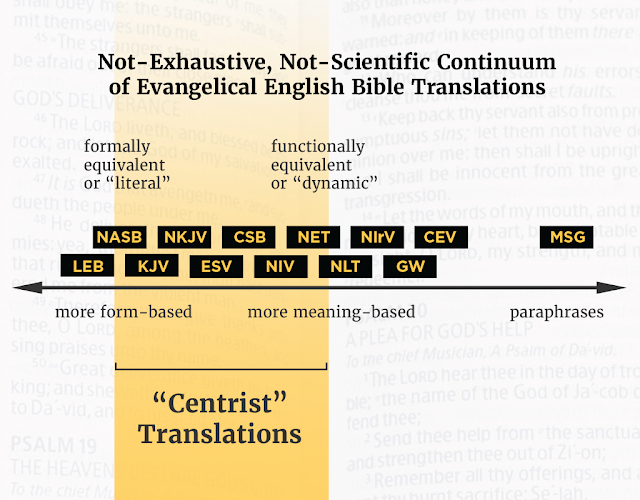From a blog by Mark Ward at the website, Evangelical Textual Criticism
Evangelical Textual Criticism: Ward: A Rising Tide Sinks All Boats: The Legacy Standard Bible and Stewarding the Church’s Trust

The “centrist” translations are the ones that go from about the NASB on the left to the NIV on the right. These are the translations that in my unscientific experience actually get used as the main translation in doctrinally sound evangelical churches. (I could be generous and include the NLT, too.)
Any further toward the left than the NASB and you cross into translations that are designed to be Bible study tools for those who know the original languages (the NASB itself is also often used this way). My own employer’s Lexham English Bible, born as a set of interlinear glosses, is an example. I see room for more translations that are hyper-literal like the LEB, because no one sees them as competing with the centrist ones to be used in churches. They are tools for study.
Any further to the right than the NIV and you cross into translations that, for all their genuine usefulness, are generally perceived to do “too much interpreting” to be useful for all the varied needs of the average church. Some people take what I’ve just said to be a criticism; I don’t. Not infrequently, I need the help the NLT’s—and even The Message’s—interpretation provides. These are useful Bible study tools, if you know what they’re aiming at. But careful preachers of the kind ETC serves have voted with their feet: they generally stick to the centrist translations unless they are serving people without high school educations—which is precisely what I did very happily with the New International Reader’s Version (NIrV) for almost six years in a weekly outreach ministry.
Quite a few English Bibles exist that aren’t on that chart, because they just aren’t popular enough to warrant mention or can’t realistically hope to be used in actual churches. ...
Evangelical Textual Criticism: Ward: A Rising Tide Sinks All Boats: The Legacy Standard Bible and Stewarding the Church’s Trust

The “centrist” translations are the ones that go from about the NASB on the left to the NIV on the right. These are the translations that in my unscientific experience actually get used as the main translation in doctrinally sound evangelical churches. (I could be generous and include the NLT, too.)
Any further toward the left than the NASB and you cross into translations that are designed to be Bible study tools for those who know the original languages (the NASB itself is also often used this way). My own employer’s Lexham English Bible, born as a set of interlinear glosses, is an example. I see room for more translations that are hyper-literal like the LEB, because no one sees them as competing with the centrist ones to be used in churches. They are tools for study.
Any further to the right than the NIV and you cross into translations that, for all their genuine usefulness, are generally perceived to do “too much interpreting” to be useful for all the varied needs of the average church. Some people take what I’ve just said to be a criticism; I don’t. Not infrequently, I need the help the NLT’s—and even The Message’s—interpretation provides. These are useful Bible study tools, if you know what they’re aiming at. But careful preachers of the kind ETC serves have voted with their feet: they generally stick to the centrist translations unless they are serving people without high school educations—which is precisely what I did very happily with the New International Reader’s Version (NIrV) for almost six years in a weekly outreach ministry.
Quite a few English Bibles exist that aren’t on that chart, because they just aren’t popular enough to warrant mention or can’t realistically hope to be used in actual churches. ...
